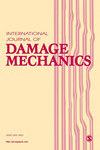Phase-field damage simulation of subloop loading in TiNi SMA
IF 3.9
2区 工程技术
Q2 MATERIALS SCIENCE, MULTIDISCIPLINARY
引用次数: 0
Abstract
In practical applications, TiNi shape memory alloys (SMAs) exhibit behavior that can pose a challenge with current constitutive models and their implementations in finite element method (FEM) software. TiNi SMA devices typically operate in the forward or reverse martensitic transformation regime, which is known as subloop loading. During such cyclic loading–unloading, the hysteresis stress–strain loop changes because of material damage, which can be considered the fatigue of TiNi SMAs. During both the loading and unloading processes, the stress plateau decreases. At the same time, the accumulated (residual) martensitic transformation strain increases. In this study, the experimental investigation results and observations of the aforementioned phenomena are presented. Next, the phase-field damage model is employed, along with a modified Lagoudas constitutive model, to simulate the change in stress–strain hysteresis. Furthermore, a fatigue function is used to simulate the accumulation of martensitic transformation strain. The experimental stress–strain response is compared with the simulation results, and good quantitative and qualitative agreement is obtained. The damage and martensitic volume fraction with respect to strain are discussed for full-loop and subloop loading. The observations and conclusions, as well as open questions, are presented. Possible directions for future research are provided.钛镍 SMA 亚环加载的相场损伤模拟
在实际应用中,钛镍形状记忆合金(SMA)表现出的行为可能会对当前的构成模型及其在有限元法(FEM)软件中的实施带来挑战。钛镍形状记忆合金(SMA)设备通常在正向或反向马氏体转变状态下工作,这被称为亚循环加载。在这种循环加载-卸载过程中,滞后应力-应变环会因材料损坏而发生变化,这可视为钛镍 SMA 的疲劳。在加载和卸载过程中,应力平台都会下降。同时,累积(残余)马氏体转变应变增加。本研究介绍了上述现象的实验研究结果和观察结果。接着,采用相场损伤模型和改进的拉古达斯构成模型模拟应力-应变滞后的变化。此外,还使用疲劳函数来模拟马氏体转变应变的积累。实验应力-应变响应与模拟结果进行了比较,结果在定量和定性方面都非常吻合。讨论了全环和亚环加载时损伤和马氏体体积分数与应变的关系。提出了观察结果和结论,以及有待解决的问题。还提供了未来可能的研究方向。
本文章由计算机程序翻译,如有差异,请以英文原文为准。
求助全文
约1分钟内获得全文
求助全文
来源期刊

International Journal of Damage Mechanics
工程技术-材料科学:综合
CiteScore
8.70
自引率
26.20%
发文量
48
审稿时长
5.4 months
期刊介绍:
Featuring original, peer-reviewed papers by leading specialists from around the world, the International Journal of Damage Mechanics covers new developments in the science and engineering of fracture and damage mechanics.
Devoted to the prompt publication of original papers reporting the results of experimental or theoretical work on any aspect of research in the mechanics of fracture and damage assessment, the journal provides an effective mechanism to disseminate information not only within the research community but also between the reseach laboratory and industrial design department.
The journal also promotes and contributes to development of the concept of damage mechanics. This journal is a member of the Committee on Publication Ethics (COPE).
 求助内容:
求助内容: 应助结果提醒方式:
应助结果提醒方式:


